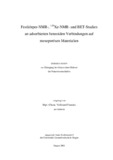Citation link:
https://nbn-resolving.org/urn:nbn:de:hbz:467-1490Files in This Item:
| File | Description | Size | Format | |
|---|---|---|---|---|
| francke.pdf | 12.24 MB | Adobe PDF |  View/Open |
| Dokument Type: | Doctoral Thesis | metadata.dc.title: | Festkörper-NMR, 129 Xe-NMR- und BET-Studien an adsorbierten benzoiden Verbindungen auf mesoporösen Materialien | Authors: | Francke, Volkhard | Institute: | Fachbereich 8, Chemie - Biologie | Free keywords: | Oberflächenadsorption, Silicagel, Xenon-NMR-Spektroskopie | Dewey Decimal Classification: | 540 Chemie | GHBS-Clases: | UZS | Issue Date: | 2001 | Publish Date: | 2006 | Abstract: | Festkorper-NMR, 129 Xe-NMR- und BET-Studien an adsorbierten benzoiden Verbindungen auf mesoporosen Materialien In dieser Arbeit konnten mit Festkorper-NMR-spektroskopischen Studien an beladenen Silicagelen erstmals Analogien zur Xenon-NMR-Spektroskopie und BET-Physisorption nachgewiesen werden. Sie liefert einen Beitrag zur Vertiefung des Verständnisses über die Adsorption fester organischer Adsorptive auf mesoporosen Materialien und zeigt mit neuen Aspekten Perspektiven für zukünftige Studien auf. Mit der Festkorper-NMR-Spektroskopie kann die Beladung des Silicagels mit organischen Adsorptiven durch das Auftreten einer adsorbierten und kristallinen Spezies direkt verfolgt werden. Durch die eingeführte Adsorptionstechnik der Kugelmühle für diese Systeme, steht in Zukunft eine standardisierte Methode zur Verfügung. Wesentliche Vorteile sind die gute Reproduzierbarkeit der Ergebnisse und variabel einstellbare Adsorptionsparameter. Die starke Abhängigkeit der NMR-spektroskopischen Großen des Modellsystems Silicagel und Hexamethylbenzol (HMB) gegenüber einer großen Anzahl von Adsorptionsparametern wurde in zahlreichen Experimenten demonstriert. Aus den Ergebnissen ergaben sich Beweise für einen direkten Kontakt zwischen dem organischen Adsorptiv und des Silicagels. Anhand der Xenon-NMR-Spektroskopie wurde an einem mit HMB beladenen Silicagel 22 erstmals eine Koaleszenz der Signale adsorbierter Xenon-Spezies demonstriert. Die freie Aktivierungsenthalpie betrug ∆G ≠ ≈ 50 kJ mol -1 . Weiterhin konnte eine Abhängigkeit der Signalintensität des Tieffeldsignals (adsorbiertes Xenon) und des Hochfeldsignals (freies Xenongas) vom Massenverhältnis an HMB und Silicagel vorgestellt werden. Schließlich wurden BET-Physisorptionsexperimente an Silicagelen durchgeführt, die man unter Anwendung der Kugelmühle mit HMB belud. Ein steigender Gehalt des organischen Adsorptivs äußerte sich in einem linearen Abfall der spezifischen Oberfläche bis hin zur Monoschichtkapazität des Silicagels. Die Monoschichtkapazitäten ließen sich problemlos bestimmen. In früheren Studien war dies an Proben, die mit Hilfe der Adsorptionstechnik des Morser präpariert wurden, gescheitert. Mit Festkorper-NMR-spektroskopische Messungen wurde abschließend erstmals eine Brücke zu BET-Physisorptionsdaten geschlagen This thesis presents proof of existing analogies of Xenon-NMR-Spectroscopy and BET-Physisorption as related to studies conducted on Solid-State-spectroscopic experiments of loaded silica for the first time. This study contributed to a deeper understanding of the adsorption of solid organic adsorptives on mesoporous materials presenting new aspects and perspectives for future studies. Solid-State-NMR-Spectroscopy enables the observation of the process how the silica is loaded with organic adsorptives through the appearance of adsorbed crystalline species. The introduction of the ball mill method as an adsorption technique can be used as a standardized method for the future. The important advantage is in the methods reproducibility of the results and variable adjustable parameters of adsorption. Many experiments showed the strong dependence of NMR-spectroscopic parameters on the silica and hexamethylbenzene (HMB) model systems against a great number of adsorption parameters. The result gave proof of the direct relation between organic adsorptive and silica. The aid of Xenon-NMR-Spectroscopy demonstrated the coalescence of signals from the adsorbed xenon species on silica 22 which was loaded with HMB. The amount of the free activation enthalpy was ∆G ≠ ≈ 50 kJ mol -1 . Furthermore, it show the dependence of the intensity of low field signal (adsorbed xenon) and high field signal (free xenon gas) to the mass ratio of silica and HMB. Investigations conducted on BET-Measurements of silica, which were loaded with HMB using the ball mill technique showed, increased content of organic adsorptives lead to a linear drop of the specific surface ultimately reaching the level of the silica monolayer. In the experiment, determining the capacity of the silica monolayer was - contrary to earlier attempts with the mortar treatment, successfully achieved without any problems. Furthermore for the first time a bridge between Solid-State-NMR-Measurements to BET-Physisorption data has been established. |
URN: | urn:nbn:de:hbz:467-1490 | URI: | https://dspace.ub.uni-siegen.de/handle/ubsi/149 | License: | https://dspace.ub.uni-siegen.de/static/license.txt |
| Appears in Collections: | Hochschulschriften |
This item is protected by original copyright |
Page view(s)
363
checked on Nov 25, 2024
Download(s)
413
checked on Nov 25, 2024
Google ScholarTM
Check
Items in DSpace are protected by copyright, with all rights reserved, unless otherwise indicated.

